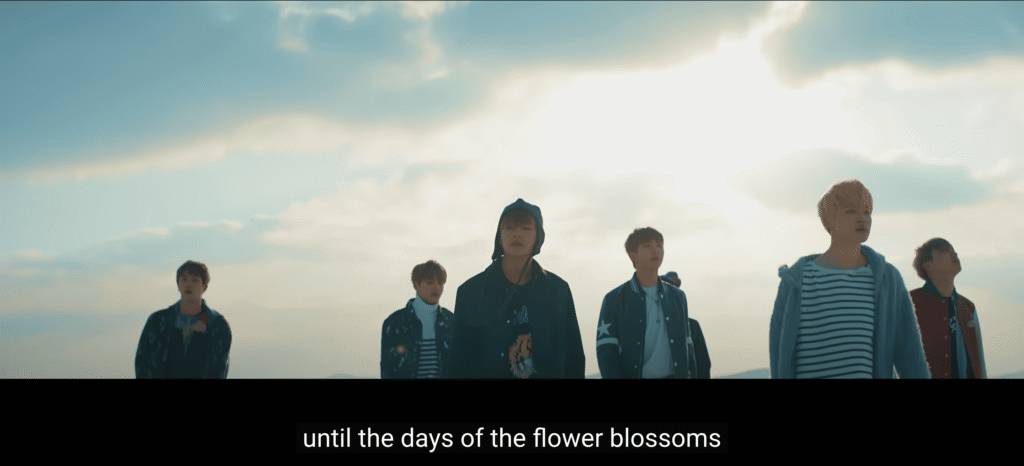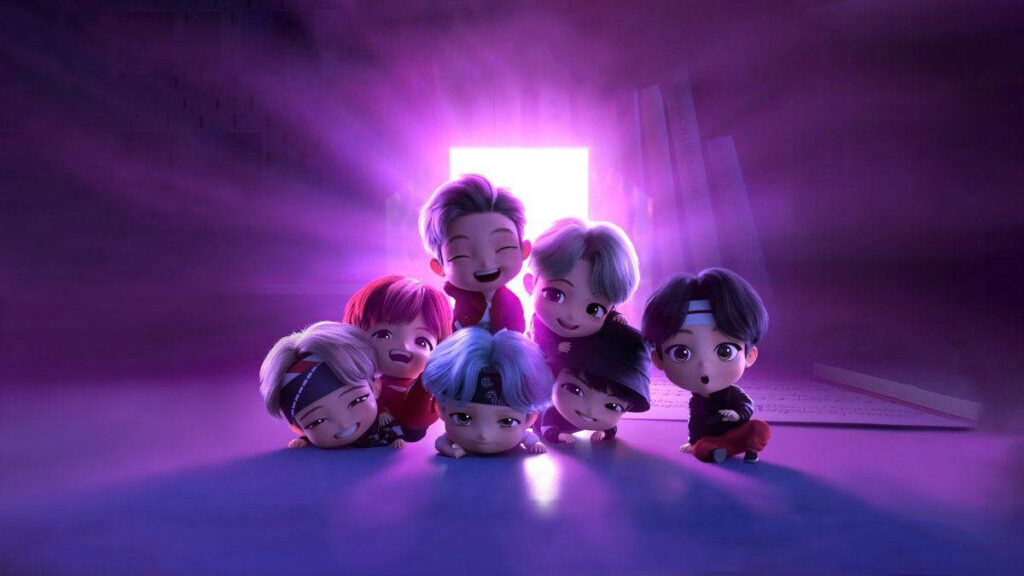
BTS “Spring Day” isn’t just a song; it’s a cultural phenomenon that has touched millions of hearts worldwide and continues to chart years after its release. This emotional ballad has become BTS’s longest-charting song and a symbol of hope, longing, and healing for ARMY and listeners everywhere.
In this blog post, I’ll explore the deep meaning behind “Spring Day,” uncover the theories and symbolism woven throughout the music video, break down its key live performances, and understand why this track remains one of BTS’s most beloved and significant songs.
What Is The Meaning Behind BTS Spring Day?
BTS’s “Spring Day” (봄날) is a touching ballad that explores themes of longing, loss, and hope. The song reflects the emotional pain of missing someone while believing that one day, you’ll meet again.
Much like winter turning into spring, the lyrics symbolize that even after a period of sadness or separation, warmth and reunion will return. “Spring Day” captures the bittersweet emotions of waiting for someone who is far away—whether due to distance, loss, or life’s circumstances.
Often interpreted as one of BTS’s most emotionally powerful songs, “Spring Day” continues to resonate with listeners for its message of comfort, healing, and enduring connection.
Rolling Stone recognized the profound impact of this track by ranking it at #37 for the Greatest Songs of the 21st Century, cementing its place in music history.
The song resonates universally because it speaks to anyone who has experienced loss, grief, or separation, offering comfort in knowing that “spring will come again” and that no winter lasts forever. Its message transcends language and culture, which is why it continues to provide solace to listeners worldwide years after its release.
Read full BTS Spring Day English lyrics here.
Why is “Spring Day” By BTS So Popular?
“Spring Day” by BTS has achieved remarkable longevity because it taps into universal human emotions while maintaining cultural significance. The song’s popularity stems from its beautiful melodic composition, deeply relatable lyrics, and the comfort it provides during difficult times. Many fans turn to “Spring Day” during moments of grief, loss, or longing, finding healing in its message of hope.
Additionally, the song is widely believed to reference the Sewol Ferry tragedy of 2014, a devastating incident in South Korea that claimed over 300 lives, mostly high school students. While BTS has never explicitly confirmed this connection, the symbolism throughout the song and music video resonates deeply with those affected by the tragedy and anyone experiencing collective grief. This layer of meaning has made “Spring Day” an anthem of remembrance and healing in Korean culture.

The song’s ability to chart consistently for years – earning it the nickname “Spring Day syndrome” – demonstrates its enduring relevance. It represents BTS’s artistic maturity and their commitment to creating music that matters, music that heals, and music that brings people together through shared emotional experiences.
Also read: Who is Min Yoongi?
Detailed Breakdown of BTS Spring Day
| Released on | February 13, 2017 |
| Album | “You Never Walk Alone” (repackaged version of “Wings”) |
| Written By | RM, Suga, J-Hope, Pdogg, Adora (Kim Sang-gyeom), and “Hitman” Bang |
| Produced By | Pdogg |
What is The Theory Behind BTS Spring Day?
The most prominent theory surrounding “Spring Day” connects it to the Sewol Ferry disaster of April 16, 2014, when a ferry carrying 476 passengers, including 325 students from Danwon High School, capsized off the coast of South Korea.
The tragedy resulted in 304 deaths, and the inadequate rescue response sparked national grief and outrage.
Throughout the song and music video, numerous symbols point to this connection. The imagery of water, the abandoned shoes (reminiscent of the shoes left behind by victims), the yellow ribbons (symbols of remembrance for Sewol victims), and references to Omelas (from Ursula K. Le Guin’s story about a perfect city built on the suffering of one child) all suggest themes of collective guilt, remembrance, and longing for those lost.
The lyrics themselves speak to waiting for someone who may never return, the guilt of survivors or those left behind, and the hope that eventually healing will come – “like a small piece of dust that floats in the air, if you’re there, I’ll be there too.”
For many, “Spring Day” became an unofficial anthem of remembrance, a way to honor those lost and acknowledge grief when official channels failed to do so. It’s a song that says, “We haven’t forgotten you, and we’re still waiting for our spring to come.”
You might also like: BTS Hometowns
Spring Day Music Video Explanation
The “Spring Day” music video is rich with symbolism and emotional storytelling that deepens the song’s meaning. The video opens with the members in various states of solitude and melancholy, set against winter landscapes that mirror their emotional isolation.
Key visual elements include: the laundromat scene representing the cyclical nature of grief and the desire to “wash away” pain; the carousel symbolizing the passage of time and memories going round in circles; the train journey suggesting movement toward healing while carrying the weight of the past; and the shoes piled on the carousel – a haunting reference to the shoes left behind by Sewol victims.
The yellow-toned filters and the eventual appearance of the tree (interpreted as the “Tree of Life” or “Tree of Souls”) represent hope, growth, and the possibility of reunion in another form.
The members are shown both together and alone, illustrating how grief is both a collective and deeply personal experience. The transition from cold, blue-toned scenes to warmer, golden ones reflects the journey from winter (grief) to spring (healing and hope).
The final scenes show the members reunited by the tree, suggesting that those we’ve lost remain with us in spirit and memory. The music video doesn’t offer easy closure – instead, it acknowledges that grief is a journey, and healing happens gradually, like the slow arrival of spring after a long, harsh winter.

Final Words
“Spring Day” stands as a testament to BTS’s artistry and their ability to create music that transcends entertainment to become a source of comfort, healing, and hope. Years after its release, the song continues to chart, proving that truly meaningful music is timeless.
Whether you connect with it as a song about personal loss, collective grief, or simply the universal experience of missing someone, “Spring Day” reminds us that no winter lasts forever – spring always comes again.
For ARMY and listeners worldwide, “Spring Day” isn’t just a song; it’s a companion through difficult times, a reminder that we’re not alone in our grief, and a promise that healing, like spring, will eventually arrive.
As long as people experience loss and longing, “Spring Day” will continue to resonate, chart, and heal – making it not just one of BTS’s greatest songs, but one of the greatest songs of our time.
FAQs on BTS Spring Day
Yes, BTS’s “Spring Day” is still charting on major Korean music platforms, even years after its 2017 release. This remarkable longevity is often referred to as “Spring Day syndrome.” The song holds the record for the longest-charting track on Melon, Korea’s largest streaming platform, with over 400 consecutive weeks on the chart. Its continued success reflects the song’s timeless appeal and emotional comfort that resonates deeply with listeners.
“Spring Day” by BTS tells the story of missing someone who is no longer present, capturing the pain of separation and the hope of reunion. While BTS has never officially stated its meaning, many listeners interpret the song as a tribute to the victims of the 2014 Sewol Ferry tragedy. The music video’s imagery and lyrical symbolism support this interpretation, making “Spring Day” not just a love song but a powerful message of remembrance, grief, and healing that continues to comfort many.
“Spring Day” was written and produced by BTS members RM, Suga, and J-Hope, along with Pdogg, Adora (Kim Sang-gyeom), and Bang Si-hyuk (Hitman Bang). This collaboration between the members and BigHit producers created a song that blends personal emotion with universal themes of longing, loss, and hope.
BTS’s “Spring Day” is famous for its emotional storytelling, beautiful melody, and universal message of hope and healing. The song’s comforting lyrics have helped many listeners cope with grief and loneliness. It also holds cultural significance in South Korea as an unofficial anthem of remembrance for the Sewol Ferry tragedy. Internationally, “Spring Day” received critical acclaim—Rolling Stone named it one of the greatest songs of the 21st century!

